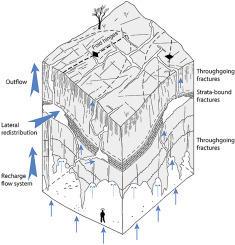当前位置:
X-MOL 学术
›
Mar. Petrol. Geol.
›
论文详情
Our official English website, www.x-mol.net, welcomes your
feedback! (Note: you will need to create a separate account there.)
Influence of fracture stratigraphy on hypogene cave development and fluid flow anisotropy in layered carbonates, NE Brazil
Marine and Petroleum Geology ( IF 3.7 ) Pub Date : 2020-04-01 , DOI: 10.1016/j.marpetgeo.2019.104207 F. Balsamo , F.H.R. Bezerra , A.B. Klimchouk , C.L. Cazarin , A.S. Auler , F.C. Nogueira , C. Pontes
Marine and Petroleum Geology ( IF 3.7 ) Pub Date : 2020-04-01 , DOI: 10.1016/j.marpetgeo.2019.104207 F. Balsamo , F.H.R. Bezerra , A.B. Klimchouk , C.L. Cazarin , A.S. Auler , F.C. Nogueira , C. Pontes

|
Abstract Fractured and karstified carbonates are often major aquifers and hydrocarbon reservoirs. The Toca da Boa Vista (TBV) and Toca da Barriguda (TBR) caves in NE Brazil, which form the longest cave system in South America, developed in a gently folded, layered and fractured Neoproterozoic carbonate sequence made of different lithological units (limestones versus siliciclastic rocks and marls) with variable bed properties (bed thickness, surface roughness of bed-to-bed interlayers) and fracture attributes (spacing, height). The functional organization of the hypogenic cave system has been recently revealed, with subdivision in three speleo-stratigraphic storeys which, from bottom to top, acted as recharge, lateral redistribution and outflow components of the rising fluid flow system, respectively. Structural analysis and new fracture data from TBV and TBR indicate that the stratigraphic setting controlled the fracture pattern development during two tectonic phases, which determined the fluid flow anisotropy during speleogenesis. We found that mechanical and fracture stratigraphy, in conjunction with bed thickness and bed-to-bed interlayer characteristics, controlled the spacing and height of fractures and, as a result, strongly influenced the fluid flow pattern and functional organization of the cave system. In particular, bed-normal rising fluids localized along m-to tens of m-spaced throughgoing fractures developed in the lower and upper storeys, whereas horizontal and bed-parallel fluid flow was focused in a package of thin carbonates, siliciclastics and marls with cm-spaced, strata-bound fractures. This fluid flow anisotropy is attained also due to the presence of rough-walled, bedding-parallel interlayers (i.e., burial stylolites) in the lower massive grainstone which hampered bed-parallel flow, and smooth, planar bedding-parallel interlayers which enhanced lateral fluid movements in the well-layered and fractured middle storey units. Therefore, we conclude that in heterolithic layered carbonate packages, the intricate hypogenic karst pattern is related to heterogeneous fluid flow behaviour associated with the structural complexity imparted by the mechanical versus fracture stratigraphy.
中文翻译:

裂缝地层学对巴西东北部层状碳酸盐岩中下生洞穴发育和流体流动各向异性的影响
摘要 破裂和岩溶碳酸盐岩通常是主要的含水层和油气藏。位于巴西东北部的 Toca da Boa Vista (TBV) 和 Toca da Barriguda (TBR) 洞穴形成了南美洲最长的洞穴系统,发育在由不同岩性单元(石灰岩与硅碎屑岩和泥灰岩)具有可变的床属性(床厚度、床间夹层的表面粗糙度)和断裂属性(间距、高度)。最近揭示了下成因洞穴系统的功能组织,细分为三个洞穴地层,从下到上,分别作为上升流体流动系统的补给、横向再分布和流出组件。TBV 和 TBR 的构造分析和新裂缝数据表明,地层环境控制了两个构造阶段的裂缝模式发展,这决定了成岩过程中流体流动的各向异性。我们发现,机械和裂缝地层,结合床层厚度和床间夹层特征,控制着裂缝的间距和高度,因此强烈影响了洞穴系统的流体流动模式和功能组织。尤其是,沿上下层发育的 m 到数十个 m 间隔的贯穿裂缝局部地层正常上升流体,而水平和床平行流体流动集中在薄碳酸盐、硅质碎屑和泥灰岩的包裹中,这些流体的流动集中在 10 厘米的薄碳酸盐岩、硅质碎屑岩和泥灰岩中。 - 间隔的,地层约束的裂缝。这种流体流动的各向异性也是由于在较低的块状颗粒岩中存在粗糙的壁面、平行层理的夹层(即埋藏的缝合线),这阻碍了层层的平行流动,而光滑、平面的平行层理的夹层增加了横向流体分层良好且破碎的中层单元的运动。因此,我们得出结论,在异质层状碳酸盐岩包中,复杂的下源岩溶模式与非均质流体流动行为有关,与机械地层与裂缝地层赋予的结构复杂性相关。平面层理平行夹层增强了分层良好和断裂的中间层单元中的横向流体运动。因此,我们得出结论,在异质层状碳酸盐岩包中,复杂的下源岩溶模式与非均质流体流动行为有关,与机械地层与裂缝地层赋予的结构复杂性相关。平面层理平行夹层增强了分层良好和断裂的中间层单元中的横向流体运动。因此,我们得出结论,在异质层状碳酸盐岩包中,复杂的下源岩溶模式与非均质流体流动行为有关,与机械地层与裂缝地层赋予的结构复杂性相关。
更新日期:2020-04-01
中文翻译:

裂缝地层学对巴西东北部层状碳酸盐岩中下生洞穴发育和流体流动各向异性的影响
摘要 破裂和岩溶碳酸盐岩通常是主要的含水层和油气藏。位于巴西东北部的 Toca da Boa Vista (TBV) 和 Toca da Barriguda (TBR) 洞穴形成了南美洲最长的洞穴系统,发育在由不同岩性单元(石灰岩与硅碎屑岩和泥灰岩)具有可变的床属性(床厚度、床间夹层的表面粗糙度)和断裂属性(间距、高度)。最近揭示了下成因洞穴系统的功能组织,细分为三个洞穴地层,从下到上,分别作为上升流体流动系统的补给、横向再分布和流出组件。TBV 和 TBR 的构造分析和新裂缝数据表明,地层环境控制了两个构造阶段的裂缝模式发展,这决定了成岩过程中流体流动的各向异性。我们发现,机械和裂缝地层,结合床层厚度和床间夹层特征,控制着裂缝的间距和高度,因此强烈影响了洞穴系统的流体流动模式和功能组织。尤其是,沿上下层发育的 m 到数十个 m 间隔的贯穿裂缝局部地层正常上升流体,而水平和床平行流体流动集中在薄碳酸盐、硅质碎屑和泥灰岩的包裹中,这些流体的流动集中在 10 厘米的薄碳酸盐岩、硅质碎屑岩和泥灰岩中。 - 间隔的,地层约束的裂缝。这种流体流动的各向异性也是由于在较低的块状颗粒岩中存在粗糙的壁面、平行层理的夹层(即埋藏的缝合线),这阻碍了层层的平行流动,而光滑、平面的平行层理的夹层增加了横向流体分层良好且破碎的中层单元的运动。因此,我们得出结论,在异质层状碳酸盐岩包中,复杂的下源岩溶模式与非均质流体流动行为有关,与机械地层与裂缝地层赋予的结构复杂性相关。平面层理平行夹层增强了分层良好和断裂的中间层单元中的横向流体运动。因此,我们得出结论,在异质层状碳酸盐岩包中,复杂的下源岩溶模式与非均质流体流动行为有关,与机械地层与裂缝地层赋予的结构复杂性相关。平面层理平行夹层增强了分层良好和断裂的中间层单元中的横向流体运动。因此,我们得出结论,在异质层状碳酸盐岩包中,复杂的下源岩溶模式与非均质流体流动行为有关,与机械地层与裂缝地层赋予的结构复杂性相关。











































 京公网安备 11010802027423号
京公网安备 11010802027423号